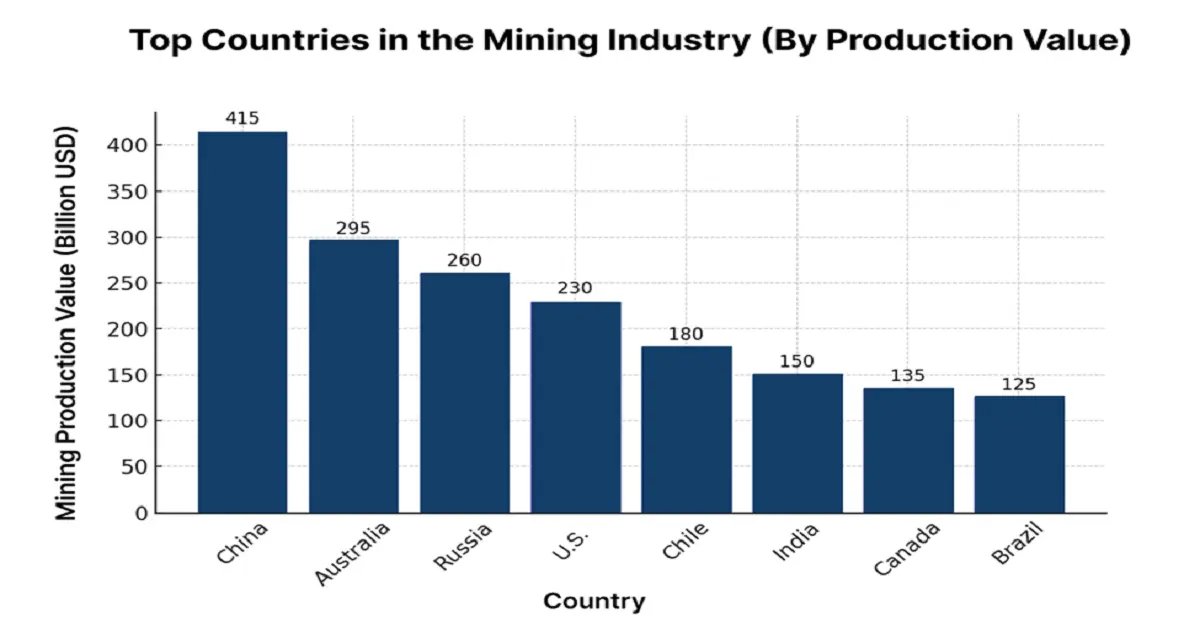Published Date : 26 September 2025
Posted by : Ipseeta Dash
The mining industry is a cornerstone of the global economy, providing the raw materials essential to power infrastructure, technology, manufacturing, and clean energy. From metals like copper and gold to industrial minerals such as limestone and coal, mining helps industries ranging from construction to technology. From the iron used in construction to the lithium in electric vehicle batteries, mining supports almost every aspect of the modern era. Though its economic contributions are unavoidable, the industry also faces growing scrutiny over environmental impacts and ethical challenges. This article highlights the vital role of the mining industry, analyzing its economic contribution, environmental and social effects, recent technological progress, and the future path ahead.
The Global Economic Impact of Mining
Mining continues to play an important role in supporting global economic growth. As per the International Council on Mining and Metals (ICMM), the sector contributes between 6% and 7% of the world GDP, both through its direct operations and in supplying necessary raw materials. The global mining market was valued at approximately $2.1 trillion in 2024, with forecasts expecting it will reach $2.7 trillion by 2035, fueled by rising demand for critical minerals used in clean energy and digital technologies. Mining revenues are closely tied to commodity cycles, with prices and output fluctuating on the basis of geopolitical stability, technological demand, and environmental regulations.

Key Segments of the Mining Industry
Mining is not a monolithic industry; it is divided into different segments based on the type of material being extracted.
1. Metallic Minerals: This segment has both precious metals like gold, silver, platinum, and base metals as iron, copper, aluminum, and zinc.
- Copper: Global copper production jumped to 22 million metric tons in 2023 (USGS, 2024), driven by the push for electric vehicles and renewable energy grids.
- Gold: Around 3,100 metric tons were mined in 2023. The World Gold Council, 2024 reports China, Australia, and Russia are expected to be the top producers in the coming years.
- Iron Ore: The OEC report 2023 stated that iron ore was valued at $128 billion in global exports in the year 2022, as a result of demand from the construction and manufacturing industries in China.
2. Non-Metallic Minerals: These comprise industrial raw materials like gypsum, limestone, and clay used in construction, fertilizers, and manufacturing purposes. The limestone market was valued at $78 billion in 2023, primarily driven by the global construction boom.
3. Energy Minerals: This includes coal, uranium, and other fuel-related minerals. Although renewable energy is rising, coal still plays a vital role in energy security. Coal production was around 8.7 billion metric tons in 2023, with China and India being major consumers according to the IEA, 2024.
4. Rare Earth Elements (REEs) and Gemstones: REEs like neodymium and dysprosium are necessary for magnets in wind turbines and EV motors. Global REE output jumped to 300,000 metric tons in 2023, with China controlling 70% of the supply according to USGS 2024.
Employment and Social Contributions
Mining supports millions of jobs around the globe. The World Bank estimates that more than 40 million people work directly in the mining sector, with an additional 100 million in supporting industries such as transportation, refining, and equipment manufacturing. In emerging countries, mining can be a primary source of employment and local investment. For instance:
- In Peru, the Las Bambas copper mine contributes $1 billion annually to the local economy and provides over 8,000 direct jobs (MMG, 2023).
- In Indonesia, nickel mining has boosted local infrastructure and created several jobs in the Sulawesi region.
However, social issues such as displacement, labor rights violations, and conflicts with indigenous communities continue to challenge the industry's social license to function.
Environmental Impacts of Mining
Despite its economic importance, mining can have serious environmental concerns. These range from greenhouse gas emissions to deforestation, water pollution, and biodiversity loss.
Key Environmental Statistics:
- The mining sector is responsible for 4-7% of global greenhouse gas emissions, mainly due to fossil fuel use in machinery and smelting operations (ICMM, 2023).
- The World Bank Report 2023 states that mining operations consume 7–9 billion cubic meters of water annually, comparable to the water needs of one billion people.
- Acid mine drainage (AMD), generally from abandoned mines, can contaminate water sources for decades, affecting communities and ecosystems.
Sustainable Initiatives:
- Companies like BHP and Rio Tinto are investing heavily in renewable energy. The ICMM, 2024 states that as of 2023, 15% of global mining operations used renewable energy, up from 8% in 2018.
- Electric mining equipment, such as Caterpillar’s electric haul trucks, is being deployed to lessen diesel consumption by about 30%.
- About 40% of large-scale mines now make use of closed-loop water systems, reducing freshwater withdrawals by 25% since 2015.
Technological Advancements in Modern Mining
Digitalization and automation are changing how mining is performed. Technology not only accelerates operational efficiency but also strengthens safety and environmental output. The major innovations include:
- Automation and Robotics: Autonomous trucks and drills, used in about 20% of large-scale mines, have increased productivity by 15–20% while reducing workplace accidents.
- Artificial Intelligence: Predictive maintenance supported by AI reduces equipment breakdown chances by 32%, helping save millions in maintenance costs.
- Drones and GIS Mapping: Now a standard in over 50% of modern mines, drones enhance geological surveys, monitor environmental changes, and equipment.
- Blockchain: Used for tracking minerals like cobalt and lithium, blockchain ensures ethical sourcing. In 2023, 10% of cobalt mines used blockchain systems for supply chain traceability.
The Future of Mining: Trends to Watch
The mining sector is undergoing a pivotal transformation. Several trends are set to define the mining industry:
- Rise in Demand for Critical Minerals: Powered by the growing demand for batteries and clean energy technologies, minerals such as lithium, cobalt, and nickel are expected to experience a 400% boost in demand by 2030, as reported by the IEA, 2024.
- Recycling and Circular Economy: The use of recycled metals is gradually rising as industries aim to reduce the pressure on primary resources. In 2023, about 35% of the copper supply worldwide came from recycled sources, helping to reduce reliance on newly mined materials (ICMM, 2024).
- Deep-Sea and Space Mining: Innovations in exploration now extend beyond Earth. There are already 10 deep-sea mining projects in the Pacific Ocean focusing on polymetallic nodules, and space-focused firms like AstroForge aim to begin asteroid mining by 2030 (ISA, 2024).
- Technological Upgrades in Mining: The combination of IoT, big data, and AI is expected to save the mining industry over $100 billion annually by 2030 through operational efficiencies and predictive analytics techniques.
Conclusion
The mining industry remains an indispensable part of the global economy, supplying the raw materials that increase industrial growth, innovation, and sustainable development. While its economic and employment contributions are commendable, the industry faces mounting pressure to evolve amid environmental challenges, technological shifts, and geopolitical complexities. Moving forward, mining companies will need to balance profitability with responsibility, choosing greener technologies, engaging with local communities, and committing to ethical practices across the supply chain. As the demand for critical minerals increases, especially in support of clean energy and digital transformation, mining will continue to shape the future of economies worldwide.
Contact Us







